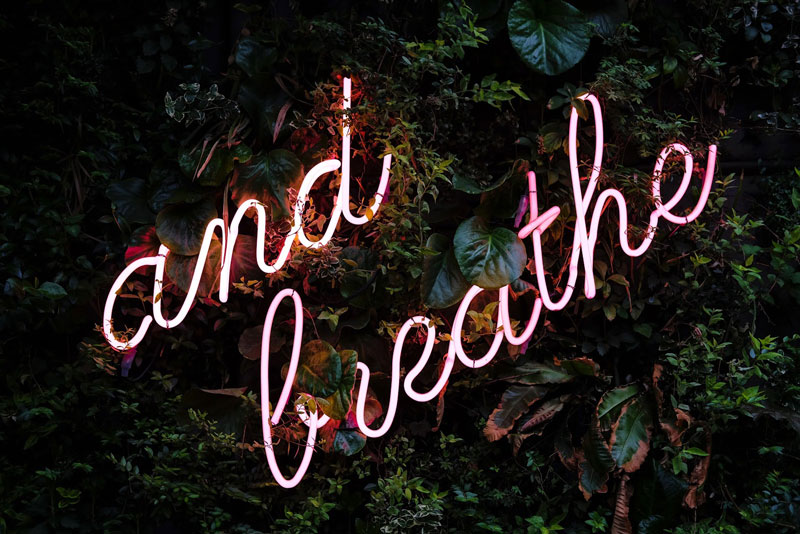
Breathe for Bliss with Breathwork Therapy
Therapeutic breathwork can be both relaxing and energizing, depending on which type is being used. Breathwork therapy utilizes different kinds of breathing forms to achieve a given goal, such as improving mental, physical, and spiritual health.
There are significant benefits to overall health from therapeutic breathwork to help aid in self-healing.
- ❖ Increase Self-Awareness
- ❖ Release Negative Thoughts
- ❖ Heal Emotional Pain and Trauma
- ❖ Improve Personal & Professional Relationships
- ❖ Increase Confidence and Self-Esteem
Mental Health Issues That May Benefit from Breathwork Therapy
- ❖ Trauma and Post-Traumatic Stress
- ❖ Depression
- ❖ Anxiety
- ❖ Anger Issues
- ❖ Chronic Pain
Types of Breathwork Therapy

There are many different types of breathwork therapy practices available, but a few of the more well-known forms include:
-
- ❖ Holotropic Breathwork — The primary goal with this type of breathwork therapy is to achieve a sense of wholeness in mind, body, and spirit, as well as unblocking emotions and releasing energy.
- ➢ Enables the participant to access unconscious experiences through altered and controlled breathing
- ➢ A “re-birthing effect” takes place to help release energy blockages that have been stored in the body and mind due to repressed trauma
- ❖ Holotropic Breathwork — The primary goal with this type of breathwork therapy is to achieve a sense of wholeness in mind, body, and spirit, as well as unblocking emotions and releasing energy.
-
- ❖ Clarity Breathwork — The main goal of this form of breathwork therapy is to support healing, increase energy levels, and improve mental focus.
- ➢ This type of breathwork differs from holotropic as it does not focus on specific trauma but rather issues that hinder energy levels
- ➢ Helps to release emotional energy that is hindering a person and keeping them stuck
- ❖ Clarity Breathwork — The main goal of this form of breathwork therapy is to support healing, increase energy levels, and improve mental focus.
-
- ❖ Biodynamic Breathwork —- The primary goal with this form of therapeutic breathwork is to restore the balance between the mind and the body.
- ➢ This breathwork recognizes that trauma is stored in both psychological and physical ways
- Focuses on self-transformation
- ❖ Biodynamic Breathwork —- The primary goal with this form of therapeutic breathwork is to restore the balance between the mind and the body.
- ❖ Transformational Breathwork — The main goal is to transform one’s life using hands-on, sound, and conscious invocation for spiritual self-empowerment.
- ➢ There are three levels involved in transformational breathwork which uses the full diaphragmatic breath:
- First Level — Opens and clears any areas of restricted breathing patterns
- Second Level — Helps mitigate trauma and negativity held in the subconscious mind, including repressed negative beliefs and memories that are stored on the cellular level
- Third Level — Allows us to consciously to connect to our self in new ways
- ➢ Helps a person feel lighter and more coherent in the way they think and feel
- ➢ There are three levels involved in transformational breathwork which uses the full diaphragmatic breath:
All forms of breathwork therapy include a variety of exercises.
Types of Breathwork Exercises
The exercises require deep and focused breathing for an extended amount of time.
-
- Box Breathing — This exercise, also called square breathing, is significantly beneficial to calm and regulate the autonomic nervous system (ANS) as well as reducing stress.
- Start by slowly exhaling out of the mouth to remove all the oxygen from the lungs
- Inhale slowly to a count of four and hold the breath for another count of four
- Exhale slowly to a count of four expelling all air from the lungs and abdomen
- Box Breathing — This exercise, also called square breathing, is significantly beneficial to calm and regulate the autonomic nervous system (ANS) as well as reducing stress.
-
- Continuous Circular Breathing — This breathwork therapy exercise is a state of sustained breathing without holding the breath at any time.
- Full, deep breaths
- Breathing in and out continuously
- Creating a circle of breathing
- Continuous Circular Breathing — This breathwork therapy exercise is a state of sustained breathing without holding the breath at any time.
-
- 20 Connected Breaths — In this exercise, the participant inhales and exhales a total of 20 times.
- Four sets of short breaths and one deep breath
- Breathing through the nose
- A non-ordinary sensation may take place with this exercise
- 20 Connected Breaths — In this exercise, the participant inhales and exhales a total of 20 times.
- 4-7-8 Breathing — This exercise is designed to help bring a person into a deep state of relaxation, and is especially helpful for those who struggle with insomnia and anxiety.
- Inhale through the nose for a count of four
- Hold the breath while counting to seven
- Exhale the inhalation for a count of eight

The way we breathe affects how our mind and body work together as one unit. When we ask what breathwork is, we now know it is a combination of techniques and exercises designed to help a person become more consciously aware of their inhales and exhales.
At Miami Hypnosis and Therapy, our mission is to help make positive changes in our clients’ lives. We do this by creating unique treatment plans with a vast array of options, including:
- Holotropic breathwork therapy
- Cognitive-behavioral therapy (CBT),
- Hypnotherapy
- Parts work therapy
- Neuro-linguistic therapy (NLP)
By utilizing more than one treatment together can expedite results, which drastically reduces overall treatment time.
Take that first step to living the life you were meant to lead without being held back. Book your appointment, and start on your “breath for bliss” journey today!
Before introducing any new therapeutic practice into your life, please consult with your primary care physician. This information above is not intended to replace advice by a medical professional. Please consult with our therapist prior to beginning any new regimen.






Write a Comment